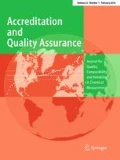Abstract
Allergens cannot at present be measured with the trueness that attends the analysis of well-characterized chemical entities such as mycotoxins where the analytes are defined and identical in sample and calibrator. By nature, allergens are nearly always a mixture of different proteins with different mass fractions of each single protein. Allergens are furthermore in a commodity with different total protein contents in the presence of an unknown matrix. To circumvent these difficulties, reference materials for allergens would be useful but until now not realized due to biological variabilities of the materials, and the contradiction between medical issues and declaration of foods due to legislation. Examples for standardization efforts are given which are (1) peanut where a common reference material not intended for allergen determination is used and (2) gluten/gliadin where the extraction procedure, the antibody and a calibrator are standardized but proficiency tests are not fit-for-purpose due to inhomogeneity of the testing material. Furthermore, the analytical minimum requirements and the declaration of egg-white proteins, caseins and lysozyme in wine are reviewed. To show one negative example for standardization efforts, milk is discussed. The possibilities and limits of reference materials for the standardization of allergen determinations are discussed.
References
Lacorn M, Immer U (2010) Standardization in allergen determination. Accred Qual Assur 15:207–216
Caroli AM, Chessa S, Erhardt GJ (2009) Milk protein polymorphisms in cattle: effect on animal breeding and human nutrition. J Dairy Sci 92:5335–5352
Farrell HM Jr, Jimenez-Flores R, Bleck GT, Brown EM, Butler JE, Creamer LK, Hicks CL, Hollar CM, Ng-Kwai-Hang KF, Swaisgood HE (2004) Nomenclature of the proteins of cows’ milk-sixth revision. J Dairy Sci 87:1641–1674
Scaloni A, Perillo V, Franco P, Fedele E, Froio R, Ferrara L, Bergamo P (2002) Characterization of heat-induced lactosylation products in caseins by immunoenzymatic and mass spectrometric methodologies. Biochim Biophys Acta 1598:30–39
Heck JML, Olieman C, Schennink A, van Valenberg HJF, Visker MHPW, Meuldijk RCR, van Hooijdonk ACM (2008) Estimation of variation in concentration, phosphorylation and genetic polymorphism of milk proteins using capillary zone electrophoresis. Int Dairy J 18:548–555
Marvin LF, Parisod V, Fay LB, Guy PA (2003) Characterization of lactosylated proteins of infant formula powders using two-dimensional gel electrophoresis and nanoelectrospray mass spectrometry. Electrophoresis 23:2505–2512
Regester GO, Smithers GW (1991) Seasonal changes in the β-lactoglobulin, α-lactalbumin, glycomacropeptide, and casein content of whey protein concentrate. J Dairy Sci 74:796–802
Ng-Kwai-Hang KF, Hayes JF, Moxley JE, Monardes HG (1987) Variation in milk protein concentrations associated with genetic polymorphism and environmental factors. J Dairy Sci 70:563–570
Taylor SL, Hefle SL, Bindslev-Jensen C, Bock SA, Burks AW, Christie L, Hill DJ, Host A, Hourihane JOB, Lack G, Metcalfe DD, Moneret-Vautrin DA, Vadas PA, Rance F, Skrypec DJ, Trautman TA, Malmheden-Yman I, Zeiger RS (2002) Factors affecting the determination of threshold doses for allergenic foods: how much is too much? J Allergy Clin Immunol 109:24–30
Lacorn M, Immer U (2011) Allergen determination in food—reference materials and traceability of results. Accred Qual Assur 16:449–452
Van Eckert R (2002) The PWG gliadin, a new reference material. In: Stern M (ed) Proceedings of the 16th meeting of the WGPAT, Nov 2001, Sitges, Spain. Verl. Wissenschaftliche Scripten, Zwickau, pp 25–27
EC 2009 Commission regulation no. 41/2009 of 20 January 2009 concerning the composition and labeling of foodstuffs suitable for people intolerant to gluten. Off J Eur Union L 16:3–5
Osman AA, Uhlig HH, Valdes I, Amin M, Mendez E, Mothes T (2001) Monoclonal antibody recognizing a potential celiac toxic repetitive pentapeptide epitope in gliadins. Eur J Gastroenterol Hepatol 13:1189–1193
Garcia E, Llorente M, Hernando A, Kieffer R, Weiser H, Mendez E (2005) Development of a general quantitative gliadin extraction procedure for unheated and heat-processed foods. Eur J Gastroenterol Hepatol 17:529–539
Thompson M, Ellison SL, Wood R (2006) The international harmonized protocol for the proficiency testing of analytical chemistry laboratories. Pure Appl Chem 78:145–196
Lopez I, Santamaria P, Tenorio C, Garijo P, Gutierrez AR, Lopez R (2009) Evaluation of lysozyme to control vinification process and histamine production in Rioja wines. J Microbiol Biotechnol 19:1005–1012
Lacorn M, Goeßwein C, Immer U (2011) Determination of residual egg white proteins in red wines during and after fining. Am J Enol Vitic 62:382–385
Weber P, Steinhart H, Paschke A (2007) Investigation of the allergenic potential of wines fines with various proteinogenic fining agents by ELISA. J Agric Food Chem 55:3127–3133
EC 2007 Commission directive no. 68/2007 of 27 November 2007 amending Annex IIIa to Directive 2000/13/EC of the European Parliament and of the Council as regards certain food ingredients. Off J Eur Union L 310:11–14
Author information
Authors and Affiliations
Corresponding author
Additional information
Papers published in this section do not necessarily reflect the opinion of the Editors, the Editorial Board and the Publisher.
A critical and constructive debate in the Discussion Forum or a Letter to the Editor is strongly encouraged!
Presented at BERM-13, June 2012, Vienna, Austria.
Rights and permissions
About this article
Cite this article
Lacorn, M., Weiss, T. & Immer, U. How should we proceed with the standardization in case of allergen determination?. Accred Qual Assur 18, 119–125 (2013). https://doi.org/10.1007/s00769-013-0965-z
Received:
Accepted:
Published:
Issue Date:
DOI: https://doi.org/10.1007/s00769-013-0965-z

